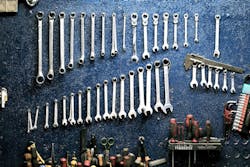Richard Ford noticed a gap in his business model. His customers needed something more. And, what they needed was a convenient way to get their vehicle towed to the dealership collision center after an accident.
York’s of Houlton, located in Houlton, Maine, is a remote town. It’s a town that Ford says is the last stop in the U.S. before you hit Canada. There aren’t a lot of companies that offer customers a towing service in the area, so dealer principal Jerry York saw an opportunity.
He hired Kevin Bailey in 2011 to be the dealership’s tow truck driver, and, when Ford joined a year later, he saw an opportunity to expand the towing business. His first step was purchasing a flatbed truck in 2013.
Ford, fixed operations director for York’s of Houlton, says that adding a towing service to the collision department increased sales by 22.4 percent. The dealership takes care of all the towing operational expenses. Bailey receives a fixed percentage of the sales. In 2018, the dealership booked $172,000 in towing revenue.
Not only is the towing service an added fee that leads to additional revenue, the collision repair shop is also able to control business in the area and bring the business directly to the collision center.
“If someone else does it, then you’re not the first option,” he says. “It’s critical for business, especially a collision center, to be a full-service dealership.”
Today, the dealership offers customers a 24/7 towing service and roadside assistance, and while adding the service to the dealership’s operations was beneficial, Ford says there were some learning curves along the way.
Problem No. 1: Obtaining the Towing Vehicles
The first hurdle that Ford ran into was figuring out a model of leasing vehicles that worked well. He kept seeing the tow trucks get damaged after a certain amount of time and needed to figure out how many years could pass before he leased more towing vehicles.
The Solution: When Ford hired Bailey, he kept the wrecker, which is a tow truck with a boom instead of a flatbed, that Bailey came with and started leasing the other towing vehicles.
The flatbed does roughly 90 percent of the sales. By leasing new and cycling every three to four years, the collision repair shop is able to keep repairs under warranty and profit consistent.
Problem No. 2: Defining the Tow Zone
Ford also realized that response time and how far the service extended was critical for the operation to run smoothly. Since, Houlton, Maine, is a relatively remote town, he needed to narrow the limit of the service.
The Solution: Ford decided to reach out to any outfit that could dispatch accident and crash calls to the collision repair center. Usually the greatest percent of towing and roadside calls are within 35 miles of the shop but the staff is willing to go further, he says. The tow truck driver is available night or day for a call and unless the tow truck is not big enough for the job or the truck is in the repair shop, the collision repair center will go out and tow the vehicle.
“Ninety-nine percent of the time, we’ll take the call,” Ford says about answering state police or customer calls.
In order to advertise the service, Ford placed electronic signs along the road, as well as a section on the website that had the information and the number that can be called. On a mobile phone, the shop’s website has a button that a customer can push to directly call Bailey, Ford says.
Problem No. 3: Staffing the Vehicles
Having only one person in charge of towing left the dealership in a tight spot. In case of an emergency, Ford knew he needed to have someone extra on hand who knows the procedure and can sub in for Bailey.
The Solution: Ford trained someone who already works in the collision repair shop to help as a backup for the tow truck. By having another person trained, the towing business has more flexibility of when and how far to pick up customers, he says.
Beginning in 2019, Ford plans to train a second person as a backup tow truck operator. He will also focus on the new trainee’s reputation and and make sure the person can be presentable at any time to the customer, he says.
Problem No. 4: Identifying Additional Revenue Opportunities
There were more aspects and ways to get revenue from towing than Ford originally anticipated. For example, the body shop can make some extra money off impounding vehicles that are towed. So, even if a vehicle is not brought into the collision repair shop, it has the opportunity to make extra revenue. Ford realized he was not using the towing service to its maximum revenue potential.
The Solution: Aside from "out of gas," lock outs, breakdowns and accidents and repossessions, the shop also takes what it refers to as "police calls." Those calls may be abandoned vehicles, arrests, or parking in a tow or snow removal zone. Operating a towing and roadside assistance service requires the shop to have an impound lot in order to hold a vehicle safely and to ensure the shop gets paid for the service. Storage charges may apply. In the case of abandoned vehicles, Ford says he occasionally has to apply for a title to dispose of the car. Or, in the case where a customer doesn't want the vehicle back, or is unable to pay, a title might be signed over to allow the body shop to junk the vehicle and cover the costs.



